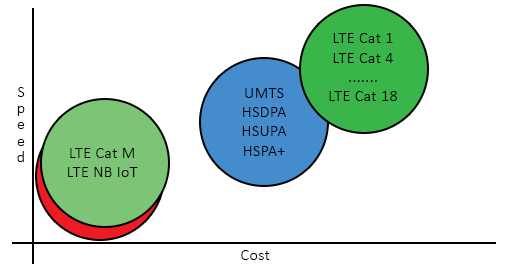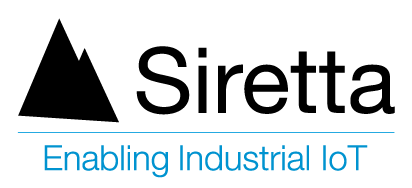To identify the ideal Industrial Cellular Modem for your application we have developed the Modem Selector Tool which is a configurable filter to narrow down the results to match your exact requirements.
LTE NB IoT is part of the LTE specification and has been designed to offer a low power solution with a low data rate and extremely low cost which is ideal for IoT solutions. The NB IoT specification is also scheduled for 3GPP release 13 but it operates on direct sequnce spread spectrum (DSSS) rather than on the LTE network. Part of the 5G specification includes enhanced machine type communication (eMTC) which will link to the NB IoT and category M LTE standards and form the basis for the future MTC of the 5G network.
The NB IoT specification defines direct sequence spread spectrum (DSSS) and the bandwidth is limited to 250Kbit/s which means that the network can be implemented directly on to sensors which will not require a gateway device to push to the cloud. This will drastically reduce the cost of the network installation.
There are several significant advantages of NB IoT.
- It offers enhanced power savings which means that devices can run for extended periods of time on battery. This is due to improved narroband sensitivity, DSSS and low bandwidth.
- It supports a large number of connections as it has been designed for small bursts of data with a narrow bandwidth.
- As LTE NB IoT utilizes a narrowband standard it means that it has substantially improved network coverage over LTE class 4, which is especially advantageous in buildings and carparks and underground.
- LTE NB IoT devices are much lower cost than full LTE category 4 and category M due to the fact that they have narrow bandwidth and reduced functionality with a lower cost radio.
- The operating costs of running an LTE NB IoT network are lower due to the fact that the network performance is similar to that of the original 2G network with low data rates and lower amounts of transferred dataIn addition to the low bandwidth requirements, NB IoT devices do not require a gateway device to connect sensors to the network and they are able to communicate directly which removes additional hardware infrastructure.

LTE NB IoT is not compatible with the existing LTE infrastructure as it operates on DSSS therefore the network providers need to update their hardware infrsructure to support NB IoT. This hardware is required to be installed at each cell tower and as such the cost to the network provider for NB IoT is significantly higher than for category M which requires a software update specified in release 13 to be rolled out over the next few years in each region.
As a result LTE NB IoT and category M are being implemented independently by each network provider in each region accross the globe. Depending on the network operators strategy defines if they are gong to support NB IoT or category M only or support both i neach region.
Defined LTE narrowband category release schedule.
| LTE Cat 1 | LTE Cat 0 | LTE Cat M1 (eMTC) | LTE Cat NB1 (NB-IoT) | EC-GSM-IoT | |
| 3GPP Release | Release 8 | Release 12 | Release 13 | Release 13 | Release 13 |
| Downlink Peak Rate | 10 Mbit/s | 1 Mbit/s | 1 Mbit/s | 250 kbit/s | 474 kbit/s (EDGE) |
| 2 Mbit/s (EGPRS2B) | |||||
| Uplink Peak Rate | 5 Mbit/s | 1 Mbit/s | 1 Mbit/s | 250 kbit/s (multi-tone) | 474 kbit/s (EDGE) |
| 20 kbit/s (single-tone) | 2 Mbit/s (EGPRS2B) | ||||
| Latency | 50–100ms | not deployed | 10ms–15ms | 1.6s–10s | 700ms–2s |
| Number of Antennas | 2 | 1 | 1 | 1 | 1–2 |
| Duplex Mode | Full Duplex | Full or Half Duplex | Full or Half Duplex | Half Duplex | Half Duplex |
| Device Receive Bandwidth | 1.4 – 20 MHz | 1.4 – 20 MHz | 1.4 MHz | 180 kHz | 200 kHz |
| Receiver Chains | 2 (MIMO) | 1 (SISO) | 1 (SISO) | 1 (SISO) | 1–2 |
| Device Transmit Power | 23 dBm | 23 dBm | 20 / 23 dBm | 20 / 23 dBm | 23 / 33 dBm |
LTE network split by LTE category and associated application examples.
| 1 Gbit/s | LTECat 4 | Aggregators / Distribution | ||
| 100 Mbit/s | Video Surveillance | Internet Hotspots | Infotainment | |
| 20 Mbit/s | IoT Gateways | Network Bridges | Server Backup | |
| 10 Mbit/s | LTECat 1 | Data Devices / Services | ||
| 5 Mbit/s | Digital Signage | Retail Kiosks | ATM | |
| 2 Mbit/s | Healthcare | Alarm Panels | POS Terminals | |
| 1 Mbit/s | LTECat M | Wearables / Meters | ||
| 250 Kbit/s | Personal Tracking | ANPR Monitoring | Telematics | |
| 100 Kbit/s | Smart Watches | Asset Tracking | AMR | |
| 10 Kbit/s | LTENB IoT | Sensors / Tagging | ||
| 5 Kbit/s | HVAC Control | Lighting | Pollution Monitoring | |
| 1 Kbit/s | Smoke Detectors | Livestock Tagging | Agriculture Monitoring | |
LTE NB-IoT Capable Range of Industrial Modems
Low Power LTE CAT NB-IoT (GL) with GPIO

ZETA-NEP-LTEM (GL) with dual RS232, USB serial & ADC
Low Power LTE-M (GL) with GPIO

ZETA-NEP-LTEM (GL) with dual RS232, USB serial & ADC
Ultra Low Power LTE Cat M (EU)

ZETA-NLP-LTEM (EU) with RS232 and USB serial
Ultra Low Power LTE CAT NB-IoT (GL)

ZETA-NLP-LTEM (GL) with RS232 and USB serial
Ultra Low Power LTE Cat NBIoT (EU)

ZETA-NLP-LTEM (EU) with RS232 and USB serial
Ultra Low Power LTE-M (GL)

ZETA-NLP-LTEM (GL) with RS232 and USB serial
ZETA Modem DIN Rail

Mount in Industrial Equipment Racks
ZETA Modem Starter Kits

Evaluate IoT Cellular Performance
